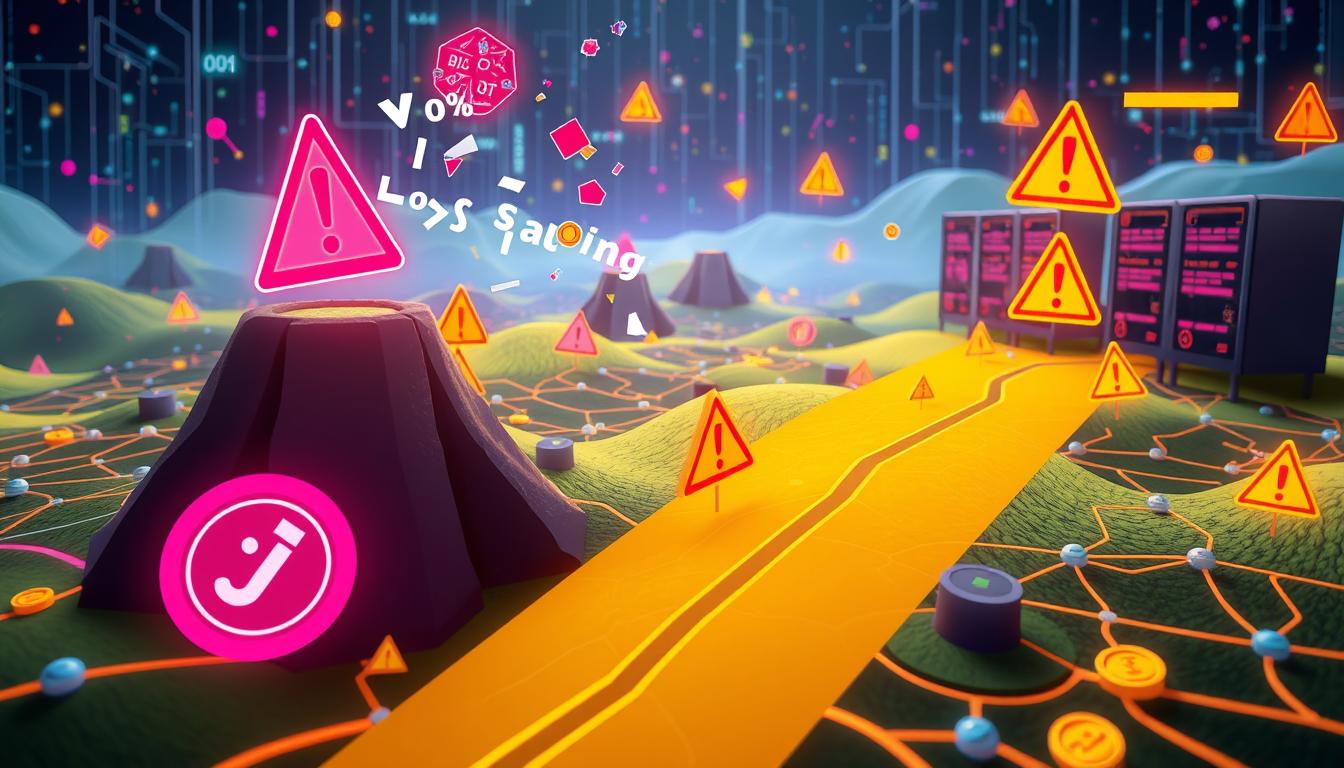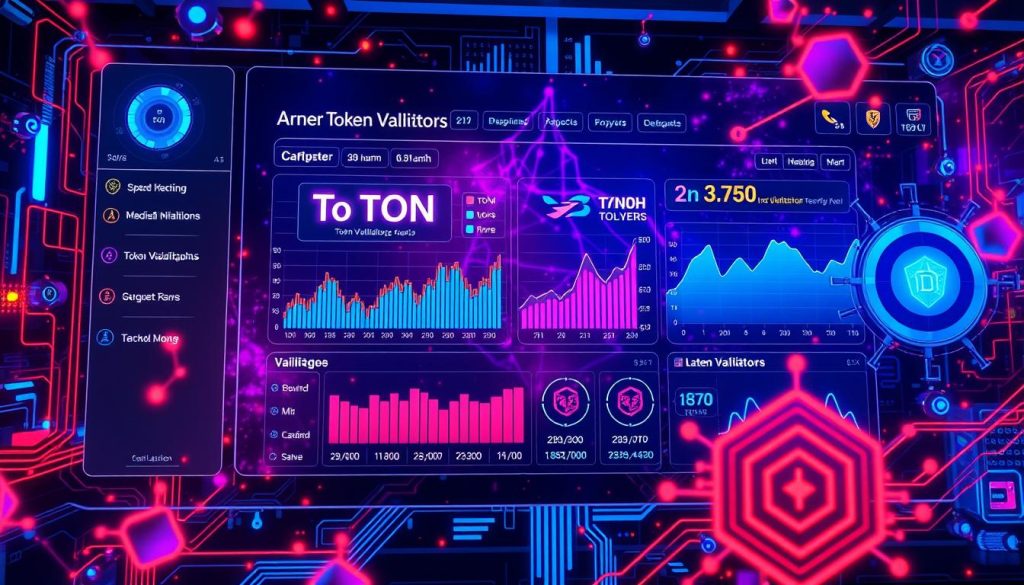Did you know nearly a third of blockchain validators might get penalized for wrongdoings or not paying attention? This fact sheds light on the importance of knowing about validator slashing in the TON network. It’s a key part of maintaining trust in the network. If you’re involved in the TON ecosystem, understanding these rules helps protect your investments. It also shows you the risks of staking and validating in this advanced blockchain. Knowing the rules about validator slashing in the TON network is crucial. It can help keep your assets safe while you explore the world of decentralized finance.
Key Takeaways
- Understanding the mechanisms behind validator slashing can protect your investments.
- Slashing is designed to uphold the integrity of TON Network validators.
- Risk awareness is vital for participants engaged in staking activities.
- Validator misbehavior can lead to significant penalties within the network.
- Knowledge of slashing rules fosters a healthier ecosystem for all stakeholders.
Introduction to TON Network
The TON network is at the forefront of blockchain innovation. It aims to make transactions faster and more scalable. It does this by using a unique mix of Master and worker chains. This setup makes processing applications quick and cheap.
This is why the TON network shines when compared to others like Ethereum. It’s made a name for itself in a crowded space.
Today, the TON ecosystem is supported by over 370 validators. These validators help maintain a strong network. As of now, $3 billion is locked in staking within this ecosystem. A whopping 550 million Toncoin has been staked, showing the community’s support1.
The TON token’s market cap has reached an impressive $13 billion1. This showcases its increasing importance in the market.
Validators in the TON ecosystem are well-compensated for their efforts. On average, they make about 50,000 TON daily1. These figures underline the lucrative opportunities available within the TON network. It’s an appealing choice for both newcomers and seasoned blockchain enthusiasts.
What is Validator Slashing in the TON Network?
Validator slashing in the TON network is key for keeping validators honest. It punishes those who act dishonestly or carelessly, harming the network. The main goal of slashing is to stop bad behavior and make sure everyone acts reliably and safely.
Definition and Purpose of Validator Slashing
Validator slashing happens when validators in the TON network break rules. They might double sign or not do their jobs right. This can hurt the network integrity. Slashing makes sure validators work well with the network’s overall goals.
How Slashing Helps Maintain Network Integrity
Slashing deters validators from acting poorly. It promotes responsible actions and accountability. This builds trust in the TON network. Financial penalties for wrong actions ensure that only serious and honest validators work on the network.
By implementing slashing, the network stays healthy. It boosts confidence among users and stakeholders in the TON ecosystem. This is crucial for keeping operations smooth and the network strong in the fast-changing digital world2.
Understanding TON Token Validator Slashing Rules
In the TON Network, validators have to follow specific TON token validator slashing rules. These ensure the network runs smoothly and fairly. Validators need to be online almost all the time. If they don’t, they might face consequences. This protects everyone involved with the TON network.
The rules are clear about penalties for not checking transactions right or acting badly. They keep the network safe and fair for everyone. Validators should know these rules well. This knowledge can help them avoid penalties and stay part of the network.
Want to learn more? You can find detailed resources about following the rules in the TON ecosystem. This will help you stay compliant and add value to the network.
Common Causes of Validator Slashing
Validator slashing keeps the TON network safe by punishing bad actions. It’s key for those in the network to know why slashing happens. There are two big reasons: double-signing and not checking transactions right. Knowing these can help you avoid problems and stay in line.
Two Main Reasons for Slashing
First off, double-signing is when a validator okays two clashing blocks. This hurts the network’s agreement and leads to quick penalties. It’s crucial for validators to be careful to avoid this. The second is when validators don’t properly check transactions. This could be because of tech issues or not paying enough attention. Either way, it messes up the network and costs validators money.
Real-world Examples of Validator Slashing
Real-life examples show how serious slashing penalties can be. For instance, one validator got slashed for not being online enough, which hurt their status a lot. Then, there was a validator who tried to pass off conflicting signatures. They ended up losing a lot of their stake. These examples make it clear: following the rules in the TON network is a must. It’s not just about formality—it affects how well everything runs and can hit validators financially.
TON Token Slashing Protocol Overview
The TON token slashing protocol is designed to keep the network safe. It makes sure validators follow the rules. This system has monitoring systems and rules that help keep everyone honest. When you learn about these parts, you’ll see how they work together to keep the network strong.
Key Components of the Slashing Protocol
Several key parts make the slashing protocol work well:
- Monitoring Systems: They watch how validators act to catch any wrongdoings.
- Governance Mechanisms: These set the rules validators need to stick to, making things clear.
- Reporting Processes: Important for finding issues quickly so they can be handled.
- Penalty Framework: It shows the penalties for different wrong actions.
Steps Taken During the Slashing Process
The process of slashing is thorough, ensuring the network’s integrity is kept.
- Detection of Misconduct: First, any odd behavior by a validator is spotted.
- Verification: The strange behavior is then double-checked to make sure it’s true.
- Notification: Validators are told about the findings to make everything fair.
- Implementation of Penalties: Lastly, penalties are given based on the rules, making sure justice is served.
Effects of Validator Slashing on Network Health
The effects of slashing on network health within the TON Network are mixed. Slashing is needed to stop misuse and keep validators honest. When slashing happens, it tells validators how critical it is to follow the rules. But, if slashing happens a lot, new validators might think twice about joining. This can affect how much the validator impact helps the network grow.
Trust in the community is key to any network’s success. Too much slashing can make people unsure about their safety and what they can earn. This doubt can lower how much people take part, which is vital for the network. It’s important to find the right balance between using slashing and keeping validators engaged.
To see the effects of slashing on the TON Network, here’s a table showing different outcomes:
| Scenario | Positive Impact | Negative Impact |
|---|---|---|
| Effective Slashing | Increases accountability among validators | Leads to lower interest in validating |
| Frequent Slashing Events | Enforces rules strictly | Makes people trust the network less |
| Community Engagement | Boosts active involvement and teamwork | Makes new validators hesitant |
It’s crucial for those involved to understand how slashing affects network health. By managing the balance between protecting the network and encouraging validator involvement, the TON community can achieve its governance goals. This supports growth and new ideas.
In conclusion, slashing is vital for keeping the network safe, but it has to be used wisely. We need to avoid discouraging people from taking part and losing their trust. Knowing how validator impact affects the network’s health shows why careful governance is necessary for continued growth and stability345.
TON Network Validator Penalties for Misbehavior
It’s important to know the TON network validator penalties if you’re joining or running validators on the TON blockchain. These penalties keep validators in line. They help keep the network running well and safely.
Types of Penalties Imposed on Validators
Validators face various penalties for breaking the rules. These can include:
- Money fines in TON tokens for certain wrongdoings.
- Being stopped from validating blocks for a while, which means they can’t earn rewards.
- Being forever removed from the list of validators if they keep breaking the rules, which affects their future chances.
The penalty for not doing their job or cheating is 101 TON. It shows how strict the rules are6.
Consequences of Repeated Offenses
Continuously breaking the rules can lead to harsher penalties. A bad validator could face:
- Bigger fines that grow with more mistakes.
- Longer time banned from validator duties, lowering their income chances.
- Losing the privilege to be a validator, which means giving up any reward claims or recognition.
There’s talk of changing how penalties work for those who don’t perform well. The idea is to make penalties target the validators’ own staked money, not just their rewards. This change is meant to make validators follow the rules better and keep the network strong6.
Tonstakers introduces smart ideas to reduce slashing risks by picking validators with good track records. They’re focused on keeping the staking environment fair and clear for everyone7.
Preventing TON Token Slashing: Best Practices
It’s crucial to keep your validator node safe in the TON network. Slashing can have big impacts. Following best practices boosts your validator’s performance and prevents TON token slashing.
Monitoring and Maintaining Validator Performance
Watching your validator’s performance closely can lower slashing risks. Make sure to check how it’s doing often. If you see performance drop, act fast to fix it. Keeping an eye on things helps keep your validator secure and slash-free.
Implementing Effective Security Measures
Strong security steps are key for a reliable validator. Use tough firewalls, defend against DDoS attacks, and make sure your node’s access is secure. Do regular security checks to find risks early. Today, only a small part of crypto videos teach these safety tips8. By learning and using these practices, your spot in the TON network is safer.
TON Validator Monitoring System
The TON validator monitoring system is key to keeping the TON network healthy. It lets validators watch their performance closely and follow rules closely. This greatly lowers the chance of problems. Using monitoring best practices makes these systems work better, helping validators quickly deal with anything unusual.
The system gives deep insights into how things are running. It checks on important things like how often validators are up, how many blocks they make, and how fast they check transactions. Keeping an eye on these things helps validators stay responsible. This is crucial for keeping users’ trust and making the network stable.
Good monitoring does more than just stop bad actions. It also helps validators act fast on possible problems. By using the best monitoring methods, validators can lower the risk of running into issues. Also, getting automatic alerts about odd actions helps create a network that reacts swiftly.
| Feature | Description | Benefits |
|---|---|---|
| Real-time Data Monitoring | Continuous tracking of validator performance metrics | Immediate detection of issues |
| Analytics Tools | In-depth analysis of operational metrics | Better decision-making capabilities |
| Automated Alerts | Notifications for unusual validator behaviors | Prompt action to avoid penalties |
TON Token Staking Consequences Related to Slashing
Validator slashing and staking rewards impact your investment in the TON ecosystem. Knowing the TON token staking consequences lets you manage risks and rewards. This knowledge is vital for your involvement.
Impact on Staking Rewards
Slashing can affect your staking rewards. When validators are slashed, a part of their stake is penalized. This can reduce profitability for all. You might see your earnings change because of validator actions.
This can affect your ability to generate stakes long-term. Recognizing how validator behavior influences your rewards is key.
Long-term Implications for Stakers
Being part of a validator’s journey has big long-term effects. Frequent slashing might make stakers want to leave a validator. This can change their overall approach. If a validator often fails to meet standards, you might get lower returns.
Knowing a validator’s history helps you make smarter investment choices. Choosing trustworthy validators in the TON Network protects your interests.
| Criteria | Stakers’ Impact | Possible Outcomes |
|---|---|---|
| Validator Performance | Direct correlation to staking rewards | Increased rewards or penalties based on actions |
| Frequency of Slashing | Potential drop in staker confidence | Lower staking activity or exit strategy execution |
| Long-term Validator Viability | Influences choice of validator | Stable returns with reputable validators |
You can navigate the TON Network by understanding these aspects. This lets you reduce risks and boost returns. For more information on staking strategies, check out TON token staking92.
Conclusion
In our summary of how the TON network handles validator slashing, we looked at key rules. These rules are very important to keeping the network safe and working well. They not only matter to validators but to everyone in the community, strengthening the overall network.
Also, understanding validator slashing is important as the TON ecosystem grows. It helps you avoid mistakes and penalties. This knowledge leads to better practices for validators, which benefits everyone. It makes the TON community stronger and more secure.
Good security and regular checks can lower the risks of validator slashing. By focusing on these areas, everyone can do better and support the TON network’s growth. Staying up-to-date is vital for making the most of staking and getting involved. This enhances trust and safety for everyone10.


















